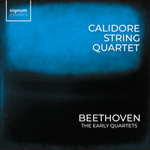
Welcome to Hyperion Records, an independent British classical label devoted to presenting high-quality recordings of music of all styles and from all periods from the twelfth century to the twenty-first.
Hyperion offers both CDs, and downloads in a number of formats. The site is also available in several languages.
Please use the dropdown buttons to set your preferred options, or use the checkbox to accept the defaults.

| Calidore String Quartet February 2025 Release» More |
The easeful B flat Andante is a rondo. As Basil Lam points out in the BBC Music Guide to the Beethoven quartets, the twelve-bar theme 'is constructed with great subtlety; the melody, begun by the second violin, is taken over and repeated by the first before the statement has been completed'. The smoothly flowing figuration of the theme is prominent in most of the movement, and Beethoven's use of contrasting harmonic areas prevents this fact from pre-empting the always welcome returns of the theme itself. At the centre is a rich development.
Quietly flexing strong muscles, the Scherzo is unaggressive and its D minor Trio decorates a four-note descending bass. Sustained brilliance in this Quartet is reserved for the finale, in a fast six-eight time. Its key and rhythms create the temptation to compare it (of course unfavourably!) with the finale of Mozart's D major Quintet — but in this case it must be Beethoven who wins the palm for sheer mastery of movement. Mozart's theme sits down with dangerous regularity, while Beethoven's flies at once into the sky, alighting when and where it wishes, and the length and size of Beethoven's paragraphs and the energy with which they are infused can be found only rarely in other composers. Here it also generates rieh and vigorous polyphony in the overwhelmingly energetic development.
from notes by Robert Simpson © 1990
L'élégant Andante en si bémol est un Rondo. Comme Basil Lam le souligne dans le Guide musical de la BBC sur les Quatuors de Beethoven, le thème à douze mesures est composé avec grande finesse; la mélodie que le second violon amorce est reprise et répétée par le premier violon avant qu'elle ne soit complètement formulée. L'ornementation fluide du thème est frappante dans la plus grande partie du mouvement et pour prévenir que cela n'anticipe les retours toujours bienvenus du thème lui-même, Beethoven utilise des passages d'harmonie contrastés. Au centre se trouve un développement magnifique.
Le Scherzo fait preuve de force sans être agressif et son Trio en ré mineur orne une basse descendante de quatre notes. Une brilliance soutenue est réservée au Finale, avec une rapide mesure à six-huit. Son ton et ses rythmes offrent une grande tentation de le comparer (défavorablement bien entendu!) au Finale du Quintette en ré majeur de Mozart, mais ici nous devons laisser la victoire à Beethoven pour sa parfaite maîtrise du mouvement. Le thème de Mozart pause avec une dangereuse régularité, alors que celui de Beethoven vole droit au ciel, se posant ici et là à sa fantaisie, et la longueur et la taille des paragraphes de Beethoven, ainsi que l'énergie qui les inspire, ne se trouvent que rarement chez d'autres compositeurs. Ici cela engendre une riche et vigoureuse polyphonie dans le développement débordant d'énergie.
extrait des notes rédigées par Robert Simpson © 1990
Français: ALBO & Co
Das ruhige B-Dur Andante ist ein Rondo. Basil Lam schreibt zu Beethoven's Quartetten in seinem BBC-Musikführer, dass das Zwölf-Takt-Thema 'mit grosser Feinfühligkeit aufgebaut ist. Die Melodie, eingebracht durch die zweite Violine, wird von der ersten übernommen und wiederholt, bevor die zweite Violine geschlossen hat'. Dieses sanft fliessend gestaltete des Themas, ist während des gesamten Satzes präsent. Beethoven gebraucht einzigartig kontrastierende Harmonieregionen und verhindert dadurch einen Aushöhlung der häufig verwendeten Wiederholungstechnik. Mit diesem Andante steht ein reichhaltiger Satz im Zentrum dieses Quartetts.
Das Scherzo ist zwar nicht aggressiv, aber mit leicht spürbarer Spannung so könnte man das Trio in D-Moll, in dem eine abfallende Basslinie geziert wird, empfinden. Ungedämpfte Brillanz vermittelt das Finale in einem schnellen Sechs-Achtel-Takt. Die Tonart und der Rhythmus verführen zu einem Vergleich (der natürlich hinkt) mit Mozart's Finale des Quintetts in D-Moll. In diesem Vergleich ware Beethoven wegen der klaren Überlegenheit in musikalischer Beweglichkeit der Vorzug zu geben. Mozart's Thema setzt sich gefahrvoll regelmässig, während Beethoven sofort in unzerstreute Reichhaltigkeit steigt. Solche in Länge und Mass perfekten Abschnitte, angereichert mit energischen Elementen, kann man nur sehr selten bei anderen Komponisten finden. Vielfältige und kraftvolle Polyphonie zeichnen diesen überwältigenden Satz zusätzlich aus.
aus dem Begleittext von Robert Simpson © 1990
Deutsch: Stefan Kapelar
 Beethoven: The early quartets Beethoven: The early quartets |
 Beethoven: String Quartets Beethoven: String Quartets‘Fine performances, always intelligent, with many considerable insights … perfect intonation and excellent ensemble and tonal blend, with first-c ... ‘Very fine … I enjoyed these performances because they deliver Beethoven as I want him, free of the biographical sensationalism. Highly recommend ...» More |

